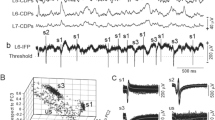Summary
1. Most of the intracellular electrophysiological data on cortical neurons has been obtained in anesthetized or reduced preparations, and differs from observations in awake, intact animals. To determine whether these differences are due to experimental techniques or physiological factors, we recorded membrane potentials intracellularly from motor cortex neurons in chronically prepared cats and monkeys under Nembutal-anesthetized, Halothane-anesthetized, and unanesthetized conditions, or during transitions between anesthetized and awake conditions. 2. Resting membrane potentials were found to depend on the anesthetic state of the animal. Membrane potentials of neurons recorded in awake animals were more depolarized than those recorded in the anesthetized state. In the awake state membrane potentials were all less than -65 mV. 3. The input resistance of neurons recorded in awake animals were significantly smaller than those measured in the anesthetized state. Action potentials recorded in awake animals typically showed an undershoot (i.e. negative values at peak), implying that voltage-dependent conductances may be altered. Undershoot of the action potential was more prominent in pyramidal tract neurons (PTNs) than non-PTNs. 4. These data suggested that in awake animals motor cortex neurons, especially PTNs, receive sustained excitatory synaptic input or neuro-modulatory activities.
Similar content being viewed by others
References
Brons JF, Woody CD (1980) Long term changes in excitability of cortical neurons after Pavlovian conditioning and extinction. J Neurophysiol 44: 605–615
Chase MH, Chandler SH, Nakamura Y (1980) Intracellular determination of membrane potential of trigeminal motoneurons during sleep and wakefulness. J Neurophysiol 44: 349–358
Desehenes M, Labelle A, Landry P (1979) A comparative study of ventrolateral and recurrent excitatory postsynaptic potentials in large pyramidal tract cells in the cat. Brain Res 160: 37–46
Deschenes M, Domich L (1983) Abolition of spindling rhythmicity in thalamocortical cells disconnected from the reticularis thalami nucleus. Neuroscience Abstr 9: 1213
Eccles JC (1964) The physiology of synapses. Springer, New York, pp 49
Evarts EV (1964) Temporal patterns of discharge of pyramidal tract neurons during sleep and waking in the monkey. J Neurophysiol 27: 152–171
Glenn LL, Dement WC (1981) Membrane potential, synaptic activity and excitability of hindlimb motoneurons during sleep and wakefulness. J Neurophysiol 46: 839–854
Inubushi S, Kobayashi T, Oshima T, Torii S (1978) Intracellular recordings from the motor cortex during EEG arousal in unanesthetized brain preparations of the cat. Jpn J Physiol 28: 669–688
Jasper HH (1954) Functional properties of the thalamic reticular system. In: Adrian ED, Bremer F, Jasper HH (eds) Brain mechanisms and consciousness, a symposium. Blackwell Scientific, Oxford, pp 374–401
Jouvet M (1972) The role of monoamines and acetylcholine-containing neurons in the regulation of the sleep-waking cycle. Ergebn Physiol 64: 166–303
Koike H, Okada Y, Oshima T, Takahashi K (1968) Accommodative properties of fast and slow pyramidal tract cells and their modification by different levels of their membrane potential. Exp Brain Res 5: 189–201
Lamarre Y, Filion M, Cordeau JP (1971) Neuronal discharges of the ventrolateral nucleus of the thalamus during sleep and wakefulness in the cat:. I. spontaneous activity. Exp Brain Res 12: 480–498
Li CL (1959) Cortical intracellular potentials and their responses to strychnine. J Neurophysiol 22: 436–450
Lodge D, Curtis DR (1977) Pentobarbitone enhancement of GABA. Nature 270: 543–544
Lux HD, Pollen DA (1966) Electrical constants of neurons in the motor cortex of the cat. J Neurophysiol 29: 207–220
Matsumura M (1979) Intracellular synaptic potentials of primate motor cortex neurons during voluntary movement. Brain Res 163: 33–48
Matsumura M (1981) Sustained excitatory synaptic inputs to motor cortex neurons in awake animals; a comparative study of membrane potential in anesthetized and unanesthetized state. Neuroscience Abstr 7: 564
Matsumura M, Woody CD (1986) Long-term increases in excitability of facial motoneurons and other neurons in and near the facial nuclei after presentation of stimuli leading to acquisition of a pavlovian conditioned facial movement. Neurosci Res 3: 568–589
Morales FR, Chase MH (1978) Intracellular recording of lumber motoneuron membrane potential during sleep and wakefulness. Exp Neurol 62: 821–827
Moruzzi G, Magoun HW (1949) Brain stem reticular formation and activation of the EEG. EEG Clin Neurophysiol 1: 455–473
Nicoll RA (1975) Pentobarbital: action on frog motoneurons. Brain Res 96: 119–123
Nicoll RA, Madison DV (1982) General anesthetics hyperpolarize neurons in the vertebrate central nervous system. Science 217: 1055–1057
Phillips CG (1956) Intracellular records from Betz cells in the cat. Q J Exp Physiol 41: 58–69
Sasaki K, Otani T (1962) Accommodation in motoneurons as modified by circumstantial conditions. Jpn J Physiol 12: 383
Sasaki K, Matsuda Y, Oka H, Mizuno N (1975) Thalamo-cortical projections for recruiting responses and spindle-like responses in the parietal cortex. Exp Brain Res 22: 87–96
Stafstrom CE, Schwindt PC, Flatman JA, Crill WE (1984) Properties of subthreshold response and action potential recorded in layer V neurons from cat sensorimotor cortex in vitro. J Neurophysiol 52: 244–263
Takahashi K (1965) Slow and fast groups of pyramidal tract cells and their respective membrane properties. J Neurophysiol 28: 908–924
Whitney JF, Glenn LL (1985) Membrane potential and input resistance of motoneurons in the awake and Halothane-anesthetized cat. Neuroscience Abstr 11: 404
Whitney JF, Glenn LL (1986) Influence of pentobarbital on motoneuron function in awake, intact cats. Neuroscience Abstr 12: 884
Woody CD, Black-Cleworth P (1973) Differences in the excitability of cortical neurons as a function of motor projection in conditioned cats. J Neurophysiol 36: 1104–1116
Woody CD, Gluen E (1978) Characterization of electrophysiological properties of intracellularly recorded neurons in the neocortex of awake cats: a comparison of the response to injected current in spike overshoot and undershoot neurons. Brain Res 158: 343–357
Author information
Authors and Affiliations
Rights and permissions
About this article
Cite this article
Matsumura, M., Cope, T. & Fetz, E.E. Sustained excitatory synaptic input to motor cortex neurons in awake animals revealed by intracellular recording of membrane potentials. Exp Brain Res 70, 463–469 (1988). https://doi.org/10.1007/BF00247594
Received:
Accepted:
Issue Date:
DOI: https://doi.org/10.1007/BF00247594




